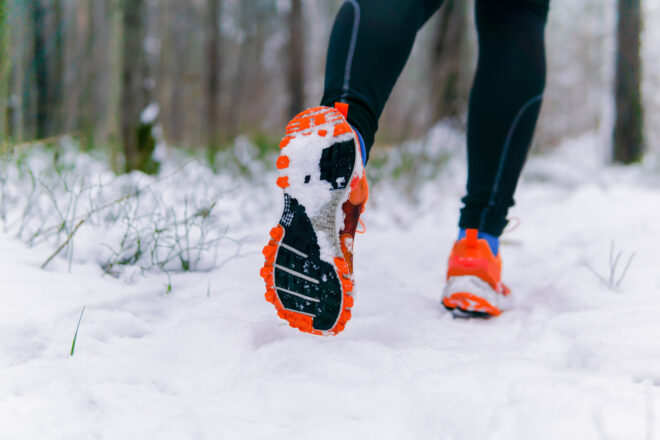Running on snow may slow you down. But it works muscle groups you may not even realize you have.
Winter running isn’t just a whim. It can help you become a better runner. But there are risks to it. You need to wear the right gear and adjust your running technique to the weather conditions.
Read on to learn everything you need to know about running in winter.
In This Article:
Is It Safe to Run on Snow?
Snow and cold temperatures are not the problem. Your body can actually run faster in colder temperatures. The problem is ice. If you know your course and watch out for ice, running on snow is not only possible but enjoyable.
Running safely on snow calls for the right running shoes and adequate running wear. We’ll talk more about these in a bit.
First, let’s look at the reasons why you may want to run on snow.
Is Running on Snow a Better Workout?
Running on snow is not unlike running on the beach. If you don’t mind the drop in temperature, that is.
Like sand, snow increases resistance and makes your run more challenging. It works more of your muscle groups. Don’t be surprised if, at the end of your snow run, you’ll feel sorer than after a normal run.
Your heart will work harder too. Your body will use brown fat to stay warm, and so you’ll also burn more calories.
Will Running on Snow Make You Faster?
Running on snow slows you down. You won’t be able to run at your usual pace, but remember that your muscles have to work harder to get through the snow.
You’re basically giving them a harder workout than under normal conditions. You’re also forcing them to adapt to the changing terrain, which can make them more responsive.
Benefits of Running on Snow
Don’t want to interrupt your running habit during winter? Running on snow has several notable benefits. Let’s zoom in on the main ones.
1. Builds muscle strength
Running on snow increases the resistance your running muscles face. So that even if you’re running slower, you’re working your muscles more.
High snow works your muscles the most. But even low snow ups your muscular workout. The bottom line is that snow running is a great way to strengthen your running muscles.
2. Works more muscles
Your hip muscles, glutes, and lower back muscles work harder when you run on snow to stabilize you. Running on snow can help some runners work underdeveloped muscles like the hips or glutes. This can reduce their risk of running injuries.
3. Builds speed
In addition to working your muscles harder, running on snow increases their responsiveness. It may also help you shed extra pounds (more about this in a bit).
The combined effect of stronger, more responsive muscles and lower body weight can make you a faster runner. How much speed you gain through running on snow depends on your current fitness level.
4. Helps you get fit faster
The extra strain that the snow puts on your muscles means your heart has to work harder too. It will pump more to get oxygenated blood to reach all your tissues. This, together with the demanding muscle workout, can help you increase your fitness level faster.
5. Helps you lose weight
When you run in winter, your body spends more energy to keep itself warm. You’ll burn more brown fat and more calories than usual per mile. If losing weight is one of the reasons you run, winter runs can help.
6. Boosts mental toughness
Running on snow is hard enough. But then throw freezing temperatures, icy wind, and ice patches into the mix, and you have to get tough or stay home.
Going out there into a small blizzard and logging the miles makes you tougher mentally. It primes you for spring runs and builds your stamina.
Snow Running Tips
Running outside in winter means you have to prepare to feel sore. It’s not supposed to be easy. But it’s worth it.
Before you head out into the blizzard, consider a few essential winter running tips. Here’s how to run on snow safely and get the most out of every run.
1. Run at lunch or mid-day
Running at lunch or mid-day means running in warmer temperatures. It also makes it easier to avoid ice since some of it will have started to melt by then. If the sun’s up, you’ll get your daily dose of natural vitamin D too.
Tip: Morning or evening winter runs often come with poor visibility. Don’t forget your headlamp.
2. Find a trail for your run
Trail running on snow makes it less likely for you to come across ice since the snow there hasn’t been disturbed. The snow may be higher, but you’ll get better traction and not worry so much about slips.
Choose a familiar trail if you can to make the run easier. But watch out since you may be in for surprises like frozen rocks or slippery slopes.
Plan your route, so you’re ready for the more difficult stretches.
3. Assess the snow
Is the snow fresh? Packed? Slushy? Icy? Getting to know the different types of snow makes choosing a trail and running on it easier.
Don’t think of snow only in terms of its volume or height. Think consistency, iciness, and slipperiness.
If you’re not sure what to expect, then consider doing a reconnaissance run. Pay attention to the snow before you and how it feels.
4. Choose an appropriate gear
Regular trail running shoes work for fresh, soft snow. Slick or slushy snow calls for shoes with spikes. You can shop running shoes for snow, but you can also use trail shoes with spikes, provided they’re not too heavy. Either way, you want to wear waterproof shoes.
The best shoes for running in snow provide above-average traction and prevent slipping. Look also for shoes with integrated knit socks that can keep you warm.
You also want clothing made from a wicking material that keeps you warm but lets your skin breathe. You also want it to be waterproof. A winter running jacket and winter running tights combo is lightweight and comfortable. Throw in a beanie and winter running gloves, and you’re good to go.
5. Improve your shoe traction
If you buy ice running shoes, make sure they’re adapted for running. Low-quality shoes are basically sneakers with lugs in them rather than proper running shoes.
Look for shoes with lugs, so you don’t have to screw your own. You can do that too, but results may vary. Even if the lugs prevent slipping, they may affect your gait and hurt your feet.
You can also try YakTrax or a similar traction device you can add to your trail running shoes. The removable steel coils and spikes provide extra traction and stability.
6. Adjust your stride and slow your pace
When running on snow, shorten your stride. This will increase your balance and stability. Handling ice patches will get easier, and you’ll be less likely to fall. The result will often be a faster cadence which will keep you running upright.
You want to run by effort rather than pace.
Don’t push yourself to run at the same pace as usual. Remember that the snow works your muscles more, even if you’re going more slowly than usual. Adapt your gait to the conditions of the road.
It goes without saying that you should leave hard sprints out of your winter running.
7. When in doubt, walk!
Does it look icy? Don’t think twice about it – slow down to a walk. Watch out for black ice, which is thin, very transparent, and very dangerous. It often forms at dawn or in the evening on roads and pavements.
8. Choose a safer alternative on freezing days!
Apart from the biting temperature, freezing days also pose the risk of ice. On such days, be wise and enjoy the treadmill. Or cross-train, do yoga, or enjoy a good movie about running.
You won’t lose anything. You’ll save yourself from getting sidelined from a bad cold or fall.
Tips for Running on Ice
Running on ice gets easier with a short stride and winterized running shoes with lugs or traction devices. Here are some other tips to consider:
- Avoid running on sides of the road or trails that get shade because, snow is more likely to form on them and less likely to melt by noon.
- Get a pair of ice running shoes or put lugs in your shoes.
- Switch from running to walking as often as you need to avoid risks.
- Avoid running on black ice, which is the most dangerous.
- Use padded shorts just in case.
- Resist the temptation to increase your stride or cadence.
- Don’t assume that the whole trail will be the same. Always step cautiously. Feel the ground under your feet.
- Think twice about listening to headphones or talking on the phone as you run because, It may distract you from paying attention to road conditions.
- Wear padded gloves in case you have to use your palms to break a fall.
Bottom Line
Now you’re ready for some running on snow… and on ice too! Grab your gear and keep our tips in mind.
Enjoy the snowflakes on your face and the crunching of the snow under your feet!
Running in winter can be magical.
References:
- Ramaswamy, S.S., Dua, G.L., Raizada, V.K., Dimri, G.P., Viswanathan, K.R., Madhaviah, J. and Srivastava, T.N., 1966. Effect of looseness of snow on energy expenditure in marching on snow-covered ground. Journal of Applied Physiology, 21(6), pp.1747-1749.
- Castellani, J.W., 2020. Running in cold weather: exercise performance and cold injury risk. Strength & Conditioning Journal, 42(1), pp.83-89.
- Mantzios, K., Ioannou, L.G., Panagiotaki, Z., Ziaka, S., Périard, J.D., Racinais, S., Nybo, L. and Flouris, A.D., 2022. Effects of weather parameters on endurance running performance: Discipline-specific analysis of 1258 races. Medicine and Science in Sports and Exercise, 54(1), p.153.
- Vihma, T., 2010. Effects of weather on the performance of marathon runners. International journal of biometeorology, 54, pp.297-306.
- Ûçok, K., Dane, Ş., Gökbel, H. and Akar, S., 2004. Prevalence of exercise-induced bronchospasm in long distance runners trained in cold weather. Lung, 182, pp.265-270.














